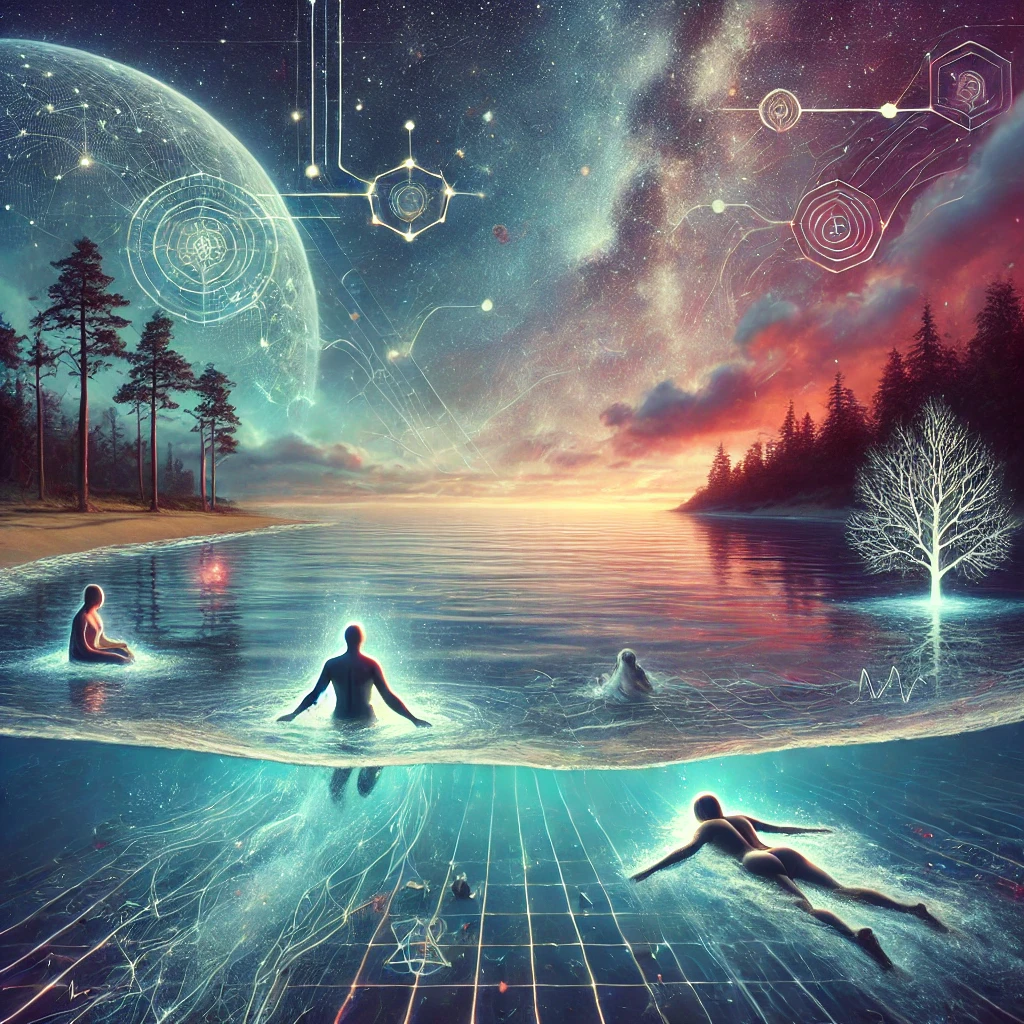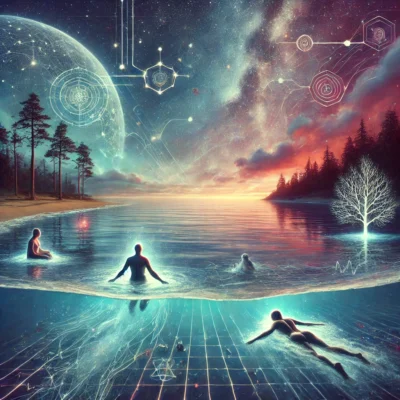
In the vast ocean of human experience, there lies a thin, often blurry line between what society deems as madness and what some cultures recognize as mysticism. Imagine two individuals adrift in this ocean—one flounders, overwhelmed by the waves, sinking deeper into chaos; the other, a mystic, learns to swim, navigating the currents with grace, ultimately reaching the shore. This analogy captures the delicate balance between the so-called “psychotic” and the mystical, challenging us to reconsider how we define and approach mental health. As Joseph Campbell said, “The psychotic drowns in the same waters in which the mystic swims with delight.”
The Diagnostic and Statistical Manual of Mental Disorders (DSM) is the cornerstone of modern psychiatric diagnosis, categorising a wide range of mental health conditions. While the DSM serves as a crucial tool for clinicians, its framework often fails to acknowledge the potential for profound spiritual and mystical experiences. What if, instead of merely labelling these experiences as disorders, we recognized them as gateways to deeper understanding?
Throughout history, countless individuals who might be diagnosed with conditions like schizophrenia, bipolar disorder or dissociative identity disorder today were once revered as visionaries, shamans, or prophets. In many cultures, what we now label as a manic episode or a psychotic break might have been seen as a profound spiritual awakening or a “spiritual emergency,” a term coined to describe crises where individuals experience intense psychological transformation. These experiences, though often overwhelming, were understood as opportunities for deep personal growth and connection with the divine. These figures were celebrated for their ability to traverse the unseen realms, bringing back wisdom to guide their communities. Yet, in today’s clinical language, their experiences could easily be pathologized, stripping them of their mystical significance.
As Carl Jung, the renowned psychologist and founder of analytical psychology, once suggested, “The mystic brings back from the experience a message of transcendence, a unifying vision. The psychotic, however, cannot bridge that divide.” Jung recognized that what we often perceive as madness might actually be an encounter with deeper layers of the psyche, a confrontation with the collective unconscious or the archetypal forces that shape human experience.
The difference between drowning in these overwhelming experiences and mastering them lies in grounding, centering, and managing one’s inner world. Practices such as meditation, breathwork, learning to work with the body, regulating the nervous system, and processing overwhelming emotions that flood the system during these intense ‘waves,’ as well as healing trauma through a spiritual trauma-informed therapy, are vital. These approaches help individuals reconnect with their bodies, release stored emotional pain, and develop resilience. Getting the right support from mental health professionals or practitioners who understand both mental health and spirituality, and who see humans as holistic beings deeply connected to nature, is crucial. Additionally, educating their support network on how to respond to their ‘unusual behaviours’ can help create a more natural and safe setting for them to ‘swim’ through to the other side. An approach that respects the individual’s unique journey through the ‘waves’ of experience, helping them distil the insights and material from the psyche and bring them into this world in a safe and grounded manner, is essential. Intentional living, coupled with these practices, are not merely therapeutic tools; they are the lifelines that can transform chaotic inner landscapes into navigable territories. By cultivating these practices, individuals can learn to swim through their experiences, rather than being consumed by them.
As a mental health professional and therapist, I deeply value the role of labels—they serve as crucial tools that help us understand the mental health landscape of each individual. However, focusing solely on these labels and confining people to the limitations of a diagnosis without seeing beyond it does a disservice to the richness of the human experience. It can cause more harm than good.
From a mystical perspective, experiences often labelled as “mental illness” offer profound insights into the human psyche. They provide a bridge between the seen and unseen worlds, allowing us to explore the mysteries of existence that lie beyond the ordinary.
Having navigated the ocean of ‘madness’ myself, I know firsthand the struggle of almost losing oneself in those deep, dark waters. Understanding the DSM and the mental health labels provided me with a map to navigate this treacherous terrain, but at times, that same map also held me back. It kept me sometimes tethered to a clinical framework that often obscured the magic hidden within the ‘madness’—the profound insights and transformative experiences that could only be accessed by looking beyond the labels.
It took me years to heal the stored traumas inside my body, regulate my nervous system, and ground myself enough to handle and integrate the wide range of lower and higher frequencies moving through me, without slipping into what I like to call ‘functional madness’ or becoming a ‘walking DSM.’ These energies manifested sometimes as spontaneous movements of my body (kriyas), guiding me into yoga positions or mudras I could not perform in a regular state. Other times, when the kundalini energy flowed through me, I found myself producing all kinds of sounds and singing in ancient languages, or channelling and speaking in tongues, with many distinct voices emerging—each an expression of something beyond the ordinary. These are just a few examples of the many non-ordinary expressions I encountered, or that others encountered, which manifested as downloads from the psyche and the unseen world we are connected with—external manifestations that we, as human beings, do not yet fully understand. Mental health professionals often dismiss these experiences or lack the knowledge to approach them appropriately, and while they may be more accepted within spiritual communities, they are still frequently misunderstood even there.
The essence of magic lies in the unknown, in the space where the material and the mystical intersect. When viewed through this lens, what we consider madness may be a form of spiritual awakening—a journey through the depths of the psyche that, if navigated with care, can lead to extraordinary insights and healing. So yes, we need both—the clinical labels and the mystical understanding, the guidance of mental health professionals, and the insight of those who dwell in the realms of spirit.
As we move forward as a society, it is crucial to adopt a more nuanced approach to mental health—one that respects the DSM’s utility but also honours the mystical dimensions of human experience. By doing so, we can create a more holistic understanding of mental health, one that allows for the integration of both the seen and unseen, the rational and the mystical. But beyond that, we must also understand the importance of regulating our nervous systems and learning to ground the immense energies that come with these experiences. These practices are crucial for emerging from the ocean, not just sane, but renewed, with a deeper understanding of ourselves and the world around us.
In the end, the ocean that separates madness from mysticism may be the same body of water. It is our ability to swim, to navigate with intention and insight, that determines whether we drown in it or emerge transformed on the other side. This reimagining of mental health invites us to view the human psyche as a complex, multifaceted realm where magic and madness are not opposites but potential allies in the quest for deeper understanding and healing.
If these experiences resonate with you or someone you know, consider the following:
Are you experiencing something that feels beyond the ordinary and need guidance to navigate it safely? Do you know someone who might be going through a challenging mental health episode or a spiritual awakening and needs a supportive, informed approach? Are you looking for a mental health professional who understands not only the clinical aspects of trauma but also the spiritual dimensions of your experiences?
In both my therapy and teaching practices, I integrate traditional mental health knowledge with a deep understanding of spiritual practices, somatic regulation, and emotional healing. My approach is holistic, bridging the gap between mental health and spirituality, offering you or your loved ones a safe and supportive space to explore and heal.
If you or someone you know could benefit from a professional who understands the complex interplay of trauma, spirituality, and emotional regulation, I invite you to explore more about my work and the services I offer. Visit my website to learn more about how I can support you on your healing journey.
Do you need help? Reach out today and take the first step towards a more balanced and integrated well-being.
